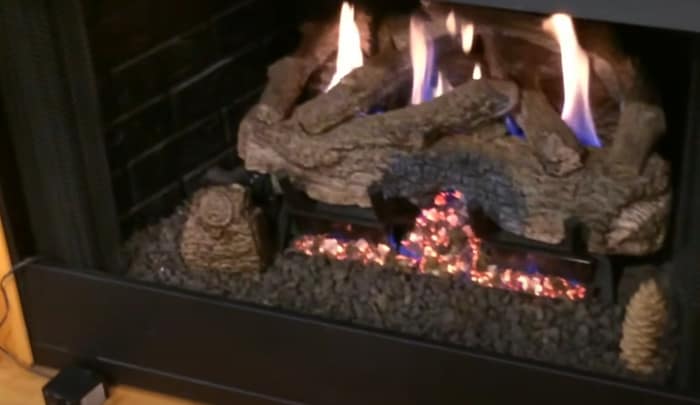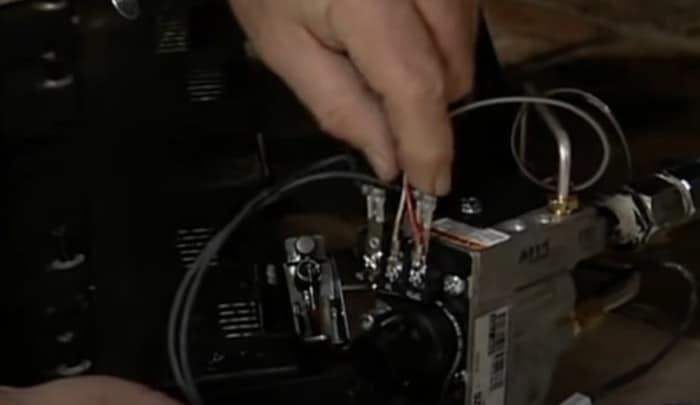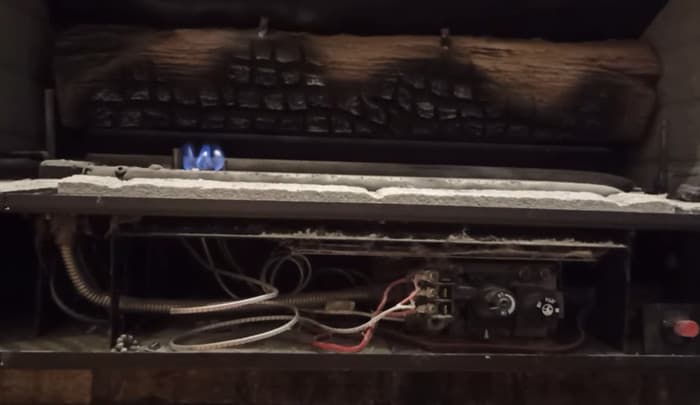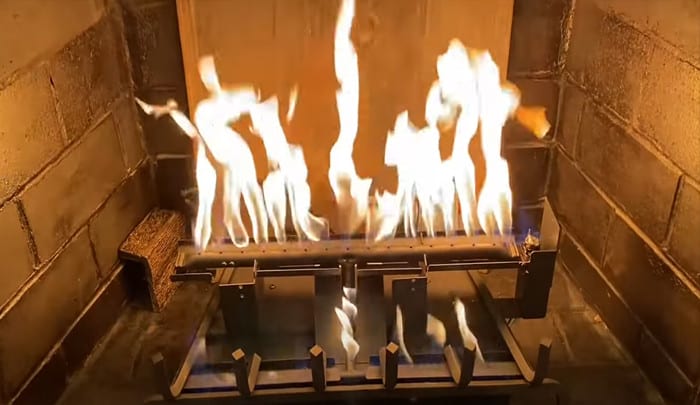With Winter just around the corner, have you been fantasizing about sitting around a real flame gas fire and cozying up for the cold months ahead? Well, look no further! Real flame gas fires have been the go-to for cozy home heating for generations and for good reason. Not only is a real flame gas fire an elegant way to heat a space, it is also incredibly efficient and cost-effective. But how much does it actually cost to run and maintain a real flame gas fire? To answer this question, we will look at what type of installation you need, how much energy it consumes, and other associated costs. So let’s get started and dig deeper into the cost of running a real flame gas fire.
The cost of running a real flame gas fire will depend on how often the fire is used and what type of gas is being used. Generally, a natural gas real flame fire will cost around $0.14 per hour to run while an LPG model could cost anywhere from $1-$2 per hour.
“One must consider several factors that could potentially influence the cost of operating a real flame gas fire. These include the efficiency of the appliance itself, variations in gas prices, and how often the fire is used. My analysis throughout the years has shown that modern gas fires are generally more cost and energy-efficient than older models due to advanced technology, hence upgrading to newer models could help in saving cost. Moreover, periodic maintenance is also key to ensuring efficiency, as poorly serviced fires tend to consume more energy.”
Phineas Hollingsworth, Energy Efficiency Consultant
Cost of Installing a Real Flame Gas Fire
Installing a Real Flame gas fire has many different costs and fees associated with it. In general, the most significant cost will be the price of the unit itself. Gas fires typically are in the range of hundreds of dollars to several thousand dollars depending on style and quality. Installation fees may or may not be included in this total price, so research should focus both on the purchase price of the fire as well as installation fees. It is important to keep in mind that the cost of installation is one area where skimping rarely pays off — in other words, cheaper labor may not result in a finished product that meets safety standards and functions correctly over time.
In some cases, additional costs must be factored into the overall installation expense. This could include items such as cabling for electrical connections, building materials for flues, ventilation systems for exhaust, fuel storage solutions, and even restrictions or permits from local authorities if necessary. All of these added costs can vary greatly depending on both location and type of unit selected. Furthermore, users must also account for the cost of hiring professional inspectors to ensure that the fire is constructed safely and legally.
Finally, households should consider the potential long-term savings they may gain after installing a gas instead of another type of fire appliance. While natural gas and propane are more expensive than traditional wood burning or electric fires out-of-pocket up front, they often provide savings due to higher efficiency over time which could outweigh initial expenses by a large margin.
The decision whether to install a Real Flame gas fire will ultimately depend on numerous factors—including budget and long-term projected savings—which vary from household to household. We’ve just discussed an overview of the installation cost and other factors associated with such decisions; next we’ll discuss how these factors can affect installation costs.

Factors Affecting Installation Costs
The cost of installing a Real Flame gas fire depends on a variety of factors. These components can include the placement, size and scope of the fireplace, as well as accessibility and the material used. Generally, installation costs range from $1,000-$5,000 with the average being around $2,500.
The most important factor to consider is the location of the fireplace. Depending on where the fireplace is going in your home, additional labor may be required to lay down a suitable foundation or add ventilation for safety reasons. This will significantly increase costs. If you already have an existing fireplace that needs to be replaced by a Real Flame gas fire, then demolition costs will also come into play.
The size and scope of your desired fireplace must also be taken into consideration when it comes to installation costs. A basic gas fire may only require minimal construction but selecting larger models like an insert or a built-in may incur additional material charges. Likewise, opting for modern features such as remote control could increase costs substantially.
Finally, the materials used during installation will play a role in determining the overall cost. Whether you are using natural stones or other building materials determines both your budget and the look of your new real flame gas fire feature.
The cost of installing a real flame gas fire varies greatly depending on these factors, so it is best to do your research before committing to any kind of fireplace project. Now that we have discussed the factors affecting installation costs, let’s move onto examining the cost of running a Real Flame Gas Fire.
Cost of Running a Real Flame Gas Fire
When running a Real Flame gas fire, one must consider the cost of operation. Depending on the model and features of the fire, these costs vary greatly and can have an impact on an owner’s budget. The cost to run a real flame gas fire is often broken up into three main categories: initial cost, installation fees, and operating costs.
Initial Cost
This will be the first major expense for most people looking to buy a Real Flame gas fire. Prices for these units range from relatively inexpensive models to more expensive, top-of-the-line designs. The price depends heavily on the size and features of the unit purchased so it is important to research and shop around carefully before making a purchase. As with any large purchase, it is also adviceable to estimate other potential costs in order to get a good idea of how much the installation will cost in total.
Installation Fees
Installing a Real Flame gas fire can come with some additional costs if you don’t have an existing setup or need to purchase new components. In almost all cases, it may be best to hire a qualified professional who specializes in gasfire installations instead of attempting to install the unit yourself. The cost of this installation process can vary based on geographical factors, desired features and labour time required as well as other various factors.
Operating Costs
The amount of money someone pays every month to operate their gas fire also varies depending on both local energy prices and the individual usage habits of each homeowner. With that being said, there are still general averages that can be estimated when trying to determine monthly operational costs associated with running a real flame gas fire. On average owners typically spend around $40-$50 per month depending on their location and usage habits .
These are the basic guidelines for considering the cost of running your real flame gas fire. There are obviously many more factors at play that affect both initial and ongoing operating costs but now that we understand these basic expenses let’s take a look at some of the other factors that may affect operating costs in our next section about Factors Affecting Operating Costs.

Factors Affecting Operating Costs
The operating costs of a Real Flame gas fire can vary significantly depending on several factors. The location and size of the fire, type of fuel used, as well as the running time are key in determining what your operating costs will be.
If your fire is situated in a place with higher temperatures or draughts, it may require you to use more fuel and operate for a longer period of time in order to achieve the desired effect. This can increase the cost of running a gas fire substantially. On the other hand, a smaller fire will require less fuel and operate for shorter periods of time, meaning that it has lower running costs.
Type of fuel used is also an important factor when considering operating costs. Choosing a more efficient fuel can save significantly on energy costs. Natural gas is usually cheaper than propane gas, so if you have access to natural gas lines then this may be the most economical option. However, some households prefer liquid propane tanks as they tend to have more flexible storage options and can provide fuel in areas where natural gas is not available.
It is also important to consider how often you plan to use your Real Flame gas fire when estimating your running costs. There are generally increased energy costs associated with turning on or off the fire frequently; however, if you are able to keep your Real Flame gas fire on for long periods at a time, your bills could be significantly lower than someone who only runs their real flame intermittently.
In conclusion, there are many variables which can influence the overall cost of running a Real Flame gas fire; from location and size to type of fuel used and length of operation. Choosing cheaper fuel sources such as natural gas over propane tanks, as well as trying to keep the fire running for sustained periods will help reduce those costs substantially. In the next section we will discuss efficiency ratings of Real Flame Gas Fires and how they can impact both cost and performance.
Efficiency Ratings of Real Flame Gas Fires
Real Flame gas fires offer a range of efficiency ratings depending on the model. For example, the Real Flame Ashley vent-free natural gas fireplace has an impressive 72% efficiency rating, while the Real Flame Morrison model is rated at 83%. In comparison, traditional wood-burning fireplaces have an efficiency rating that ranges from 10% to 20%, making them far less efficient than gas models.
Proponents of gas fireplaces claim they provide superior energy efficiency over traditional fireplaces and require much less maintenance in terms of fuel and upkeep costs. They also note that since gas models use venting systems, they are considered far safer to operate than wood-burning fireplaces. Additionally, most modern gas fireplaces produce low emissions and are environmentally friendly alternatives to standard builds.
On the other hand, some homeowners argue that the durability of wood burning fireplaces makes them a more cost-effective option in the long run. Furthermore, it is true that there is nothing quite like the smell of a real wood fire. However, if you weigh all the factors involved in terms of expense, environmental impact and safety features, it’s easy to see why many modern homeowners are turning to gas fireplaces as their preferred source of heat indoors.
Next, we will explore the cost and environmental benefits of running a Real Flame Gas Fire.

Cost and Environmental Benefits of Running a Real Flame Gas Fire
When it comes to cost and environmental benefits, running a real flame gas fire is certainly worth considering. Gas fireplaces are typically more efficient than wood burning stoves and often require less energy to maintain. For example, a natural gas insert may only use as much energy as a light bulb, making them especially cost-effective for homeowners who are looking for easier and more affordable heating options. Additionally, the emissions produced by natural gas fireplaces tend to be lower than those of traditional fires, helping to reduce the amount of pollution in the environment.
On the other hand, while natural gas fireplaces may have some environmental advantages compared to other types of fireplaces, they are still powered by combustible fuel and therefore add to greenhouse gas emissions. Furthermore, they can often produce high levels of nitrous oxides and sulfur dioxides which can also have an adverse impact on air quality.
Ultimately, making the right choice between a real flame gas fireplace versus another type of fireplace depends largely on what size of fireplace is best for your home, as well as how much energy costs where you live. However, opting for a real flame gas fireplace can provide more efficient heating than traditional wood burning hearths and may generate fewer adverse environmental impacts if operated properly.
With that in mind, let’s look at the pros and cons of a real flame gas fire compared to other types of fireplaces.
Pros and Cons of a Real Flame Gas Fire Compared to Other Types of Fireplaces
Pros of Real Flame Gas Fireplaces
When looking at the pros and cons of a real flame gas fireplace compared to other types of fireplaces, it is important to consider the convenience factor. One major pro associated with real flame gas fireplaces is the ease of use. Since they are fueled by natural gas, they require no manual ignition, making them easy and convenient to turn on and off. This can be done with just a flip of a switch or button on a remote control. In addition, unlike wood-burning fireplaces, gas fireplaces do not require any kind of periodic maintenance such as cleaning out ashes or refueling.
Another advantage of using a real flame gas fireplace is its ability to provide an adjustable heat source. When using a realistic flame gas fireplace, you can easily adjust the temperature in your home to keep it comfortable without having to mess around with different logs and different levels of intensity. You can also choose from a wide selection of designs that offer different looks as well as size options to fit in any space.
In addition, real flame gas fireplaces are more eco-friendly than other types of fireplaces as they burn clean and produce less emissions than wood-burning fireplaces. Also, since they don’t require burning wood for fuel, there is no need for purchasing additional materials like logs or kindling.
Cons of Real Flame Gas Fireplaces
Despite their many advantages over traditional wood-burning fireplaces, there are still some drawbacks associated with real flame gas fireplaces that must be taken into consideration when choosing whether or not this type of fireplace is right for you. A main con associated with this type of fireplace is the cost; it may be pricier up front than other types of fireplaces due to the installation process and cost associated with obtaining natural gas for use within the unit.
Another downside associated with real flame gas fireplaces is the potential safety hazard posed by the open flames present in the unit itself. Although these units utilize natural gas instead of wood fuel, which eliminates the need for kindling and preventing sparks from spreading, they still contain an open flame which can create hazardous conditions if not properly monitored or maintained. In addition, these fireplaces are often more susceptible to soot buildup and will require regular cleaning in order to avoid carbon monoxide poisoning.
- According to research conducted by Rinnai, running an open flued gas fire for 1 hour typically costs about $1.90.
- When considering installation and operating costs, running a contemporary freestanding or inset gas fire costs around 9.2 cents per hour.
- Depending on the type of burner used, the approximate cost of buying and running a standard size gas fire (18kW) can range from 24 cents to 45 cents per hour.

Commonly Asked Questions
What type of fuel is needed for a real flame gas fire?
The type of fuel needed for a real flame gas fire is natural gas or propane. Natural gas is the most popular option and runs on the natural gas lines that feed many homes and businesses. It is convenient, cost effective, and efficient; however, it can be subject to seasonal price fluctuations. Propane requires a tank which must be refilled periodically when the fuel runs out. It is the more expensive option but can be used in areas without access to natural gas.
Are there any potential safety hazards associated with a real flame gas fire?
Yes, there are potential safety hazards associated with a real flame gas fire. If not properly maintained and operated, gas fires can lead to fires and explosions due to gas leakage or build up of carbon monoxide inside the home. The naked flame of a gas fire also creates a risk of accidental combustion of combustible materials. Additionally, it’s important to properly ventilate any room containing a gas fire in order to prevent the buildup of harmful gases. Finally, all appliances powered by natural gas should be inspected and maintained regularly by an experienced heating specialist.
What are the average running costs of a real flame gas fire?
The average running costs of a real flame gas fire depend on the size and type of the unit, as well as the fuel costs in your area. On average, a traditional-style gas fireplace can cost between $1 – $3 per hour to operate, while a modern ventless or electric fireplace may cost around $0.50 – $2 per hour. Additionally, keep in mind that you will also need to factor in fuel costs for either natural gas or propane. Natural gas typically costs around $1/hour compared to propane which may be double the cost or more depending on where you live.
In conclusion, when considering the running cost of a real flame gas fire, it is important to factor in both the unit type and fuel costs. The overall cost will vary greatly by region, with some areas being much more affordable than others.
References
https://www.thisoldhouse.com/fireplaces/21018607/all-about-gas-fireplaces
https://www.woodlanddirect.com/top-6-vented-gas-log-sets.html





I’ve been using real flame gas fires in three of my old Victorian houses over the last 20 years and it’s true about them being cost-effective in the long run.
Despite being an industry veteran, while buying a real flame gas fire for my own house last winter, even I had to research a lot about its costs and maintenance. It’s true that the initial cost and installation may seem high, but the efficiency it provides and the monthly savings are totally worth it. In my experience, regular maintenance checks every 6 months can elongate their lifespan and maintain their functionality at peak.
I saw my gas bills significantly drop after switching from wood-burning to a real flame gas fire, making it a more cost-effective choice in the long run.
Agree with you there, Kalina. As an electrician who has installed both types of fires, I’ve noticed substantial savings on my bills since installing real flame gas fires at home.
I switched to gas fires almost ten years ago and can categorically affirm their efficiency. In comparison to my old electric heater, I noticed clear savings on my utility bill after the first year alone.
That’s a valid point Grenville, I too observed significant savings when I switched to a gas fire system in one of my properties.
Last year, I installed a new real flame gas fire into my Connecticut home. Never had I anticipated even with our bone-chilling winters, how much value it would add to not just my heating efficiency but also to my quality of life. Every morning, I wake up looking forward to that cup of tea by the fireside indulging into all the novels that were long due on my reading list. The overall cost turned out to be really affordable because it doesn’t just offer heat but sparks that joyful fire within me as well.